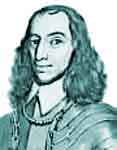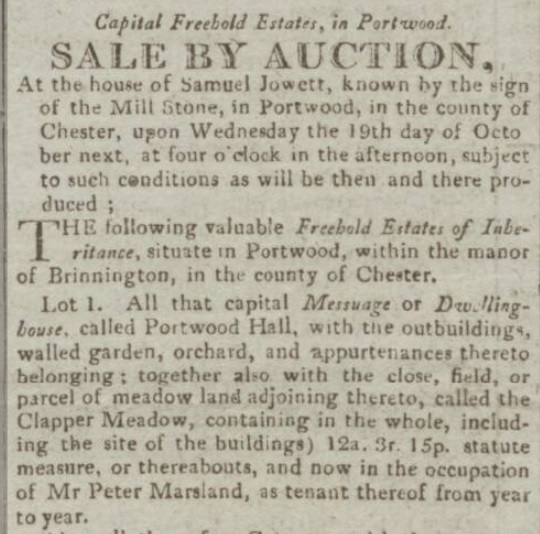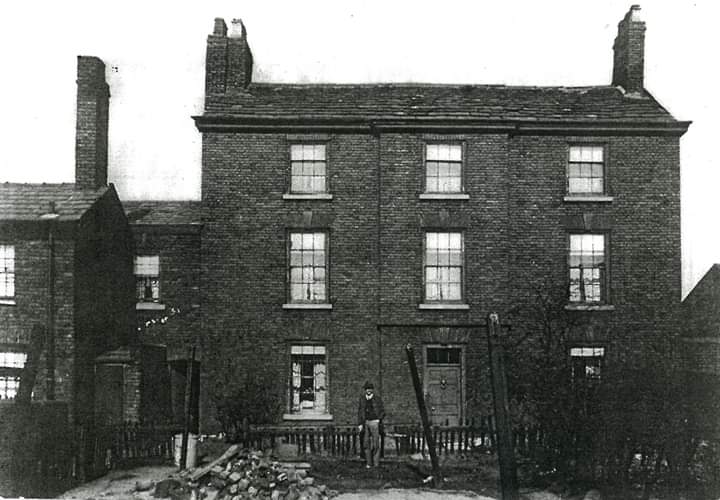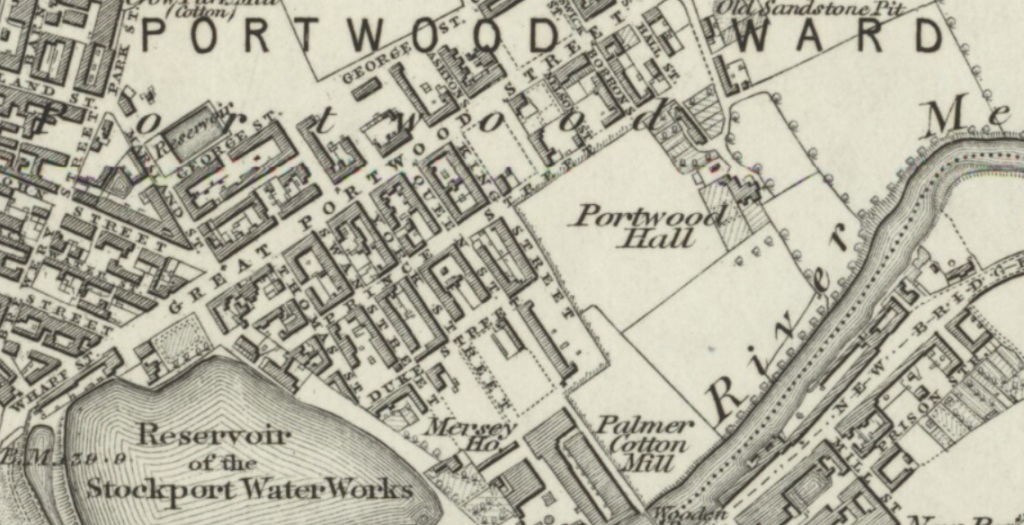Portwood Hall as we have seen, was the Manor House of Brinnington. It stood on the banks of the Mersey (note it was the Mersey here, Goyt Hall not being yet built, the Mersey started in those days at the confluence of the Goyt and Etherow, and not as is considered its source today the joining of the Goyt and Tame¹.)

The manor of Brinnington does not appear in Domesday, but in its early days it was owned by the Barons of Dunham Massey, and conferred to the third Baron, Hamon, to Robert Fitz Waltheof. This Robert is believed to be an ancestor of the Barons of Stockport. Around 1312 Robert Dukenfield obtained the manor from William, the son of Walter De Stockeport.
The Dukenfield family arose unsurprisingly in Dukinfield in present day Tameside, and also quite unamazingly the name means open land where ducks are found. An alternate, perhaps more noble theory is that the Danes were beaten back by the Saxons there, and a figure of a Raven was placed on the Danish flag and named in Saxon dialect, Dockenveldt, or Field of the Raven. The Dukenfields² obtained their first land from Matthew De Bramhall and held lands from around 1190.
Along with Lyme, Harden and Bramall, the owner of Portwood Hall was one of the four churchwardens of Stockport, an ancient right conferred by the Barons of Stockport.
Colonel Robert Duckenfield (1619-1689) was baptised at St Mary in Stockport, and Portwood Hall was probably built by his father around 1620, it was certainly in Robert’s possession.
During the civil war he joined William Brereton on the parliamentary army and fought in the siege of Manchester, and Wythenshawe Hall as well as Beeston Castle. On 25 May 1644 he was posted with his troops at Stockport bridge unsuccessfully bar the advance of Prince Rupert into Lancaster. He served under Cromwell and sat on the Court Martial of the Earl of Derby, as well as taking the Countess and her children prisoner on the Isle of Man, the Earl advised the Countess to surrender, the Colonel being a gentleman born would deal with her fairly.
After the restoration he was imprisoned in the Tower, for about a year, but on his release he returned to Duckenfield Hall where he lived and died peacefully. His statue stands today infront of Duckinfield Town Hall and the Colonel is buried at St Lawrence in Denton.

Lt Colonel Robert Duckenfield © Alan Bate 
Robert Dukenfield by Ford Of Manchester
By the 1700s, as befell many of these houses, the Hall had become a farm, and on 4 November 1740 Matthew Mayer was born in the house. In 1759 he heard John Wesley preach and converted to Methodism. In 1762 preaching firstly under Wesley’s instruction in Birmingham, he progressed his ministry through Staffordshire and as far afield as Oldham, Wesley consulted him many times, and may have stayed at Portwood with him. Fittingly in these times, he was the first to preach Methodism at Eyam from the smithy there. He didn’t get a good reception and was pelted with sods of earth as reward for his efforts
Eventually he retired to Stockport, and secured the land to erect the famous Stockport Sunday School in 1799.
After Matthew the Hall was in the possession of James Harrison a cotton spinner who built the Portwood Cut and he let the Hall out to various tenants, whilst trying to sell it. He may have lived there briefly.
We next meet Thomas Ross, a local cotton spinner who married Mary Lingard in 1805. She was the daughter of John Lingard (1751-1814), an attorney who practised from offices on Chestergate and Lancashire Hill in Stockport. John’s son, Roger Rowson Lingard became a prominent attorney at law in Stockport, and we have already met him when he married Margaretta Christiana Platt Turner of Hollywood House, and we will meet him again soon. Fittingly Thomas went bankrupt in 1807 and his father in law handled the insolvency.
Peter Marsland was then briefly a tenant before he moved to Woodbank as this sale notice in the Manchester Mercury of 11 October 1808 shows.

Another attempt was made to sell the Hall in 1810, and by now, its end was clearly in sight as it was also being offered for building land, the premises in good repair, and (in best estate agentese) at a moderate expense may be made suitable for a genteel family.
We next meet Thomas Hill in 1834 at the Hall, when he is trying out a horse in Ashton Under Lyne, which rears up and breaks his leg. The estate outside the hall is being farmed in 1841 Robert and Elizabeth Tyford and their two children. At the end of the 1840s it is still in the possession of the same Thomas Hill, a Land Surveyor, his wife Elizabeth, and their four children. Intriguingly, W Taunton Hill, his eldest son describes himself as in the Manchester trade, whatever that means³. Thomas Hill worked from offices in Ashton Under Lyne and Portwood Hall, dealing in the of tracts of land in Stockport and area, and the leasing of the Bleachworks at Reddish Mills in 1852. The family subsequently moved to Wood Hall, which we will visit another time.
After this the Hall was occupied by William Wright, a surgeon, his widow dying there in August 1856.
Heginbotham described the Hall as a beautiful mansion in the midst of fields and gardens. It had a deer park and orchards in Wesley’s time, but it fell foul to the urbanisation of Stockport, and gradually disappeared. In 1857 The Ashton Weekly Reporter in a feature titled “A Tramp through Brinnington”, considered Portwood Hall nothing particularly worthy of notice.
It appears on the 1848 Ordnance survey and the 1882 one but in later ones it was overwhelmed by housing and mills. These two appearances, show it as it tries to resist the inevitable march of industry.
However, somehow, the building remained on Borron Street in Stockport, albeit in a heavily modified state and split into many units. The original structure was said to remain under the brick exterior. It was finally demolished in 1969.

Today Borron Street is populated by industrial units and has no trace of the hall that once stood there, even Portwood Hall Road and Fold have disappeared.
¹ In Heginbotham, the argument is put forward that the source of the Mersey was in Derbyshire at Woodhead, and in fact the Etherow is the Mersey. I like that theory.
² Several Duckenfields emigrated to the United States of America, and achieved various levels of prominence, of course one of the best known being William Claude Dukenfield, aka WC Fields.
³ I’m told it means was a cotton man. Which makes sense.
Sources
Stockport Ancient & Modern, Henry Heginbotham: Marston, Searle & Rivington 1882.
The History of the County Palatine of Chester, J H Hansall: Fletcher, sold by the Author 1823
The History & Topography of Cheshire, William Pinnock, Pinnock & Maunder 1820
https://www.houseofnames.com/dukenfield-family-crest
© Allan Russell 2020


An excellent piece. Thank you for your in depth research.
LikeLike